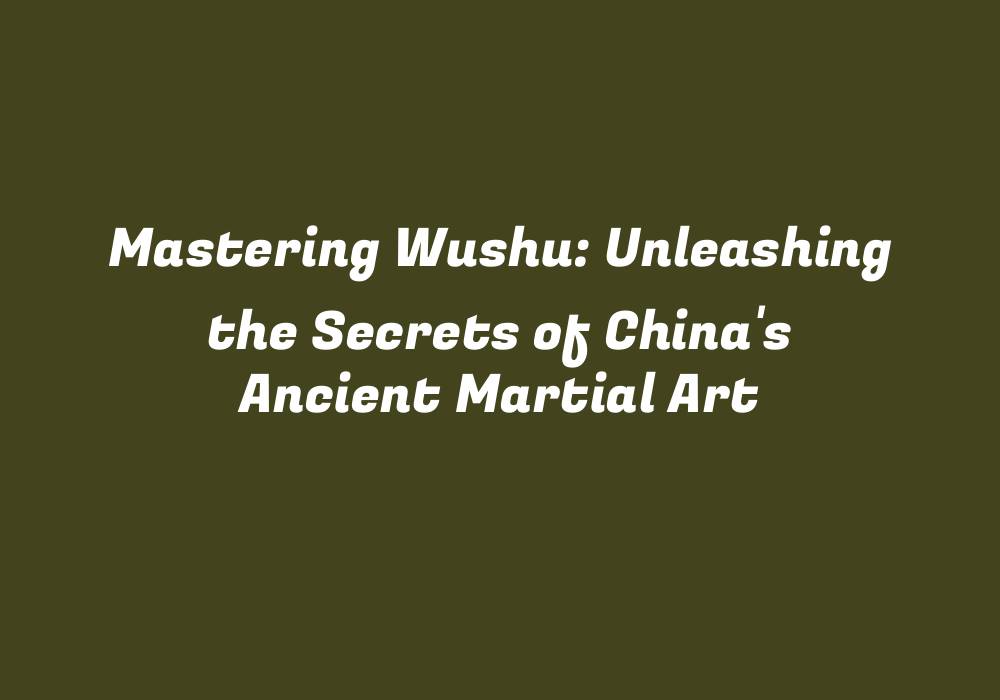Introduction
Wushu, often referred to as “China’s ancient martial art,” has a rich and storied history that dates back thousands of years. This traditional form of exercise encompasses both the physical aspects of self-defense and the mental discipline required to master it. With a broad range of styles and techniques, Wushu can be practiced for personal fitness, self-improvement, or as a competitive sport. In this article, we will delve into the secrets of wushu mastery by exploring its origins, techniques, and the philosophical principles that underpin it.
Origins of Wushu
The roots of wushu can be traced back to ancient Chinese culture. From the early days of civilization, martial arts have played a significant role in shaping the country’s history and development. Many believe that the earliest forms of wushu originated from Shaolin Temple monks who were required to demonstrate strength, agility, and wisdom through various martial techniques. Over time, these practices evolved and spread across China, incorporating elements from other schools and regions.
Mastering the Basics: Stances, Strikes, and Footwork
At the core of wushu training lies an understanding of its fundamental techniques. One must master the basics before progressing to more advanced skills, including stances, strikes, and footwork. A firm grasp of these foundational components will greatly enhance your ability to execute complex forms and routines with precision, power, and grace.
Stance Mastery: The Foundation for Wushu Performance
A strong foundation in wushu relies heavily on the mastery of different stances. Each stance has its own unique purpose and application, allowing practitioners to develop balance, stability, and flexibility while enhancing their overall physical performance. Some essential wushu stances include:
1. Bow Stance (Gong Bu): A low, wide-legged position that emphasizes power and stability. It is often used in combination with kicks and strikes.
2. Horse Stance (Mabu): A deep squat position that requires strong leg muscles and promotes overall balance and flexibility.
3. Sword Stance (Jian Bu): This stance closely resembles the horse stance but has a slightly wider leg placement and a more upright torso for increased mobility during sword routines.
4. Crane Stance (Hei Bu): A narrow, high-leg position that requires considerable flexibility and balance to maintain.
Strikes: The Heart of Wushu Combat
As a form of self-defense, wushu incorporates a wide range of strikes to protect oneself or strike an opponent. These techniques include punches, elbow strikes, and open hand techniques such as palm heel strikes (Jie Jian). Learning how to generate power and precision in each of these strikes is essential for becoming proficient in wushu combat.
Footwork: The Art of Movement
One of the most critical aspects of wushu performance lies in its footwork. Proper foot placement, weight distribution, and movement are crucial factors that contribute to a fluid, graceful execution of routines. Essential techniques include stepping, turning, and leaping. By mastering these elements, practitioners can seamlessly transition from one stance to another while maintaining control and balance throughout the performance.
Advanced Wushu Techniques
Once the foundational aspects of wushu have been firmly established, it is time to explore more advanced techniques. These include:
1. Weapons Training: Mastering the use of various traditional weapons such as staffs (gun), swords (jian), and cudgels (dao) requires a combination of strength, precision, and timing.
2. Aerial Techniques: Wushu performers are well-known for their impressive acrobatic skills, which often include jumps, flips, and aerial maneuvers. These elements add an element of entertainment and excitement to wushu routines.
3. Partner Work: Learning how to work with a partner can enhance one’s understanding of spatial awareness, timing, and coordination while practicing techniques such as Qin Na (grappling) and Sanshou (sparring).
4. Form Development: Wushu practitioners are encouraged to continuously develop new forms by combining various elements of the art, reflecting their individual style and creativity.
The Philosophical Underpinnings of Wushu
In addition to its physical components, wushu is deeply rooted in Chinese philosophy and cultural values. Practitioners often strive for self-improvement, both mentally and physically, while embodying the principles of discipline, perseverance, and respect. Wushu masters also recognize that mastery of the art does not lie solely in physical prowess but rather in the development of character and personal growth.
Conclusion
Mastering wushu requires dedication, passion, and a willingness to embrace its rich history and cultural significance. By cultivating an understanding of the art’s foundational techniques and philosophical underpinnings, one can embark on a transformative journey that not only enhances their physical abilities but also nurtures personal growth and self-discovery. Embrace the wonders of this ancient martial art, and unlock its secrets for a fulfilling and enriching practice.
